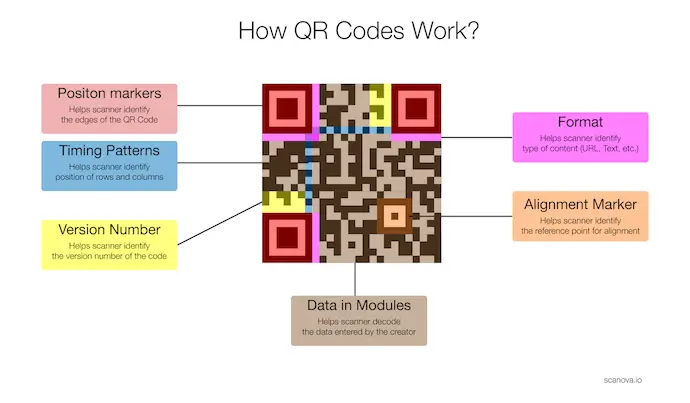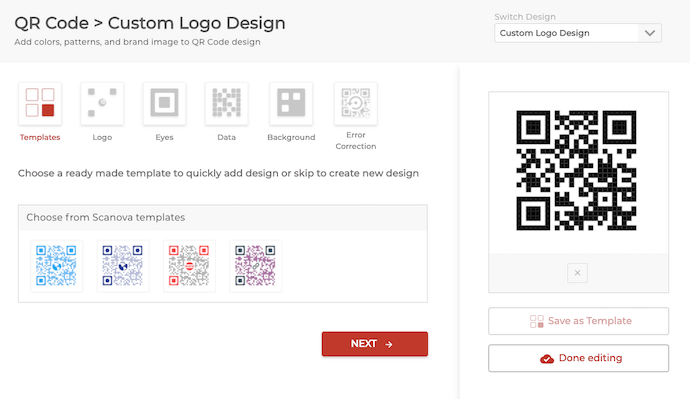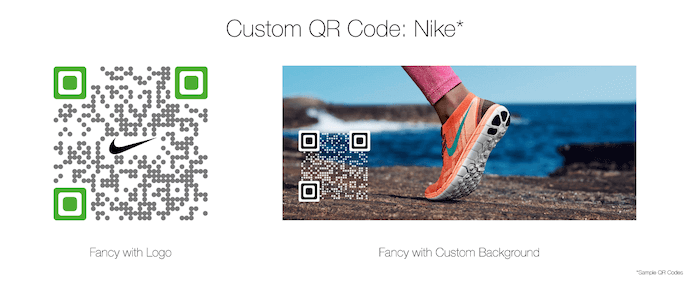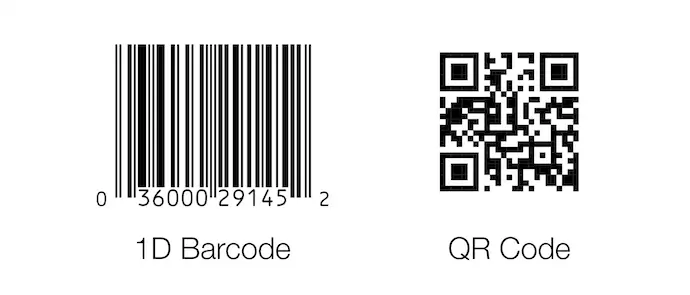Don’t know what is a QR Code or how businesses use them? Don’t worry. In this exhaustive guide, we have covered the basics of QR Code technology. We update our page often so don’t forget to add us to your bookmarks.
Read this ultimate guide to learn all about QR Codes
A. What is a QR Code?
A Quick Response Code is a popular type of two-dimensional barcode. It encodes alphanumeric information. To decode this, you can either use a handheld scanner or even a QR Code scanning application on your smartphone.
In fact, many smartphones such as iPhone, Xiaomi, Motorola, and Samsung now have an in-built QR Code scanning feature in their stock camera application.
A Japanese company, Denso Wave Corporation, developed Quick Response Codes in 1994. Their role was vehicle tracking and high-speed component scanning in the automobile industry.
B. How do QR Codes work
If you look at a QR Code, you’ll see black-colored squares (or dots) all over it. These are called data modules. The information you add to the QR Code is stored in these data modules.
Hence, every module (black or white unit block) or a string of modules either represents data or a function.
So what scanners do is—they start reading these data modules to decode the information stored in them to show the stored data to the users.
The illustration below depicts how a QR Code scanner decodes a QR Code:

Here’s a detailed guide on how QR Codes work.
Many users have some common questions before getting started with QR Codes. And you may have them too. Let’s go through these in detail:
Most common QR Code FAQs
1. What does QR Code mean?
QR stands for ‘Quick Response’. Hence, QR Code becomes Quick Response Code.
And the reason behind this name is pretty simple. Have you ever scanned a QR Code? You might have done it most probably. In case not, try scanning one now.
It’ll hardly take a second or two for to you do the needful and see the content in the QR Code. Quick, right?
That’s exactly the rationale behind the name. Since a QR Code gets scanned in no time (responds quickly), hence, the name.
2. How many times can my QR Code be scanned?
Technically, as many times as you want.
Static QR Codes, which are permanent in nature, come with unlimited scans. Once created, they can’t be deactivated. In addition, even your QR Code generator can’t limit the number of scans on them.
However, due to their limited functionality, static QR Codes aren’t really the most sought-after.
Dynamic QR Codes, on the other hand, may or may not have unlimited scans. It totally depends on your QR Code generator. Service providers such as Scanova don’t put a limit on the scans your QR Code can get.
In addition, since the dynamic ones are both editable and trackable, they’re preferred way more than the static ones. Watch this quick video for a detailed comparison of static and dynamic QR Codes.
3. Does a QR Code work forever?
As mentioned before, a static QR Code is permanent in nature, hence, works forever. But that is not the case with a dynamic QR Code.
For a dynamic QR Code to work, you need an ongoing subscription with your QR Code generator.
4. Who is a QR Code relevant for?
There’s no specific job role, industry, department, or use case that QR Codes are relevant for. In fact, it’s the quite opposite. QR Codes are so versatile that everyone is using them.
From ads and promotions to operations, they fit everywhere. For example, in 2022, they were used by Dunzo, an instant delivery app in India, used QR Code to promote its app. The response was so good (and unexpected) that the app crashed due to traffic overload.
On the other hand, many logistics companies use QR Codes for inventory management. Since QR code store way more data than barcodes and are damage resistant, they work amazingly well.
5. Can I add a design to my QR Code?
Yes, you can add a design to your QR Code. And by that, we don’t mean that you need to hire a graphic designer. Advanced QR Code generators such as Scanova offer this capability.
This feature helps you make your QR Code visually appealing in no time. Isn’t that great?
In case you didn’t get your queries answered, let us know in the comments.
Ready to move on to the next section? Let’s move ahead.
C. Using QR Codes
Since 1994, Quick Response Codes have come a long way. In the smartphone era, these square-shaped barcodes have found extensive applications.
Some of these include inventory management, marketing & advertising, security, mobile payments, education, and personal use.
Different industries are using them immensely. Statistics show that QR Code scanning was rampant across the world in 2018. And will continue to grow in 2019.
This implies that their use is soaring every day.
These 2D barcodes store information such as webpage URLs, text, and contact information.
To view this information, you simply need to scan the code using an app on your smartphone. It’s even easier than clicking a picture.
QR Codes are so easy to use that anybody can create and use them for their benefit.
Today, they are commonly added to:
- Business cards to allow people save contact details
- Prevent the spread of COVID-19 by making contact tracing, PPE kits, and vaccination better
- Class material to engage and teach children
- Hire suitable candidates for the HRs and even get a job for the jobseekers
- Print advertisements to allow readers to visit the website, register for an event, etc.
- Share live location for various use cases
- Mobile payment applications to make transactions
- Product packaging to allow consumers to get in-depth product information
- Make business processes such as sales and marketing better
- Event or travel tickets to authorize and log entry
- Make industries such as food and alcoholic beverages transparent for the customers
- Wedding invitations to make things easier for the guests
- Invitation cards to help guests get the venue location on their phone’s maps application
- Share and market your stories in various ways
- Encode a survey or form to get feedback
The list doesn’t end here. There are, in fact, many crazy and innovative use cases of QR Codes.
Generate a QR Code For Your Unique Case
START TODAY!Best Practices of Using QR Codes
If you use Google Adwords for search engine marketing, you must have an SEM expert. The expert’s job is to optimize CTR for most conversion.
Similarly, in offline-to-online marketing (QR Codes), you need to follow the best practices. You need to always ensure that the Quick Response Code:
- Is accessible to your target audience
- Is scannable
- Has clear instructions that tell the users what to do or what to expect after scanning it (e.g., “Scan me to register”)
- Is placed in an area with cellular network
- Leads to a mobile-optimized landing page
- Is downloaded in a high-resolution format such as SVG or PDF for print media
Once you know QR Code best practices, you must also know how not to use them.
For example—avoid putting the QR Code in a place with no access to mobile internet or Wi-Fi.
Or make sure it is neither too small nor too large to affect the scan ability adversely.
D. Types of QR Codes
Say the content you want people to see is ‘target data’. Target data could be a website, a word in Spanish, your phone number, or even an image.
Classification of QR Codes depends on how this data gets encoded. There are two categories of Quick Response Codes:
1. Static QR Code
In a static Quick Response Code:
- Target data is encoded directly into the code, just like numeric data is encoded in a barcode
- The more information is encoded the ‘denser’ the Quick Response Code will become
- Encoding is permanent, which means that the target data can never be edited
- It is not possible to track scanning activity
Static QR Code can encode the following information in a structured format:
- URL
- Vcard (contact details)
- Text
- Wifi network access details
- Pre-loaded SMS
- Email address
- Phone number
- Calendar event
- Bitcoin wallet address
2. Dynamic QR Code
A Dynamic QR Code is a better way of encoding URLs in a QR Code. This confers it greater functionality and flexibility. In a Dynamic Quick Response Code:
- Target data can only be a URL
- The target URL is not stored directly in the Quick Response Code. Instead, a short URL (usually provided by the QR Code service) is encoded which redirects to the target URL
- It is possible to edit the encoded target URL at any time without the need to reprint the square-barcode
- It is possible to track the scanning activity and get analytics
- You can ‘activate’ or ‘deactivate’ the Code at any time
Note that this categorization is based on how data is stored in a Quick Response Code. Based on the type of content, there can be many categories.
The number of categories of these 2D barcodes you can create depends upon the QR Code generator that you use.
Different generators offer different categories. For example, Scanova QR Code generator allows you to create more than 20 types of Quick Response Codes.
To decide which type of QR Code you need to create, think about what action do you want your target audience to take. For example, do you want them to:
1. See a website
2. See a text-based landing page
3. Listen to an audio
4. Make a payment using Paypal
5. Watch a video
6. Download a PDF
7. Follow you on social media
Once you decide what you want users to do, finalize the type of Quick Response Code you’ll create.
E. Generating a QR Code
Before you go ahead to create a QR Code, you must be clear about two things:
1. What do you want your audience to do
2. Which QR Code generator will suit your needs the best
A simple Google search on ‘QR Code generator’ will give you pages of results.
How do you then decide which service is the best for you? Will you compare all of them one-by-one?
Fret not! We’ve compiled a detailed comparison chart of the best QR Code Generator.
Once you decide on which service you’ll use, there are three ways in which you can generate QR Codes:
1. One-by-one using an online QR Code Generator
There are many online QR Code generators such as Scanova, that help you create a Quick Response Code.
All that you need to do is—specify the target data, select the type of QR Code (static or dynamic), and download its image.
You can even customize your Quick Response Codes by adding your brand color and logo.
It is a fact that customized Quick Response Codes attract many more scans than standard black-and-white ones.
Hence, if your use case is promotional (such as marketing), and you want as many people to scan your QR Code as possible, you must customize it.

(Screenshot of Scanova Quick Response Code Generator)
2. Integrating QR Code API with your own system
If you have a mobile application or an information system that needs to generate these 2D barcodes, then you need a QR Code API.
It will integrate with your system and generate a Quick Response Code on demand.
3. Bulk Generation Services
Some QR Code service providers give the option of bulk generation (or batch generation).
This is helpful in case you need (say) 10,000 Quick Response Codes each with a unique ID.
You simply need to specify the data to be encoded in a spreadsheet, upload it to the bulk generator, add a design to the QR Codes (optional), and make payment.
Once your batch is ready, you can download it.
F. Scanning a QR Code
This can be done in either of the two ways mentioned below:
1. Using a QR Code scanning application on a mobile device
If you own a smartphone that has a camera, you can decode a Quick Response Code.
There are a number of QR Code scanning applications on all major app stores of iOS, Android, Windows, and Blackberry OS platforms.
i-nigma is one such application that works well on both iOS and Android.
Also, as stated above, some smartphones now have inbuilt QR Code scanners. Check if your phone already has one.
2. Using a handheld or fixed optical scanner
You’ve seen scanners at the retail stores used to scan barcodes. Similarly, a handheld or fixed optical scanner can scan QR Codes.
These scanners are used when the scanning volume is higher in cases such as ticketing or mobile payments.
G. Advantages over Barcodes
In technical terms, 2D barcodes have the following advantages over traditional barcodes:
1. Higher Capacity
A Quick Response Code can store up to 7,089 numeric characters (without spaces) or 2,953 alphanumeric characters with spaces.
Compare this with the capacity of barcodes i.e. 20 numeric characters (without spaces).
The higher capacity of QR Codes allows them to be used in various industries. From marketing, security, payments, and other solutions.
Note that they can store web URLs, unlike barcodes.
2. Smaller Size
Compared to a barcode, a Quick Response Code can store more information in a smaller area of space.

This is helpful in inventory management as it is possible to print more QR Code labels in the same amount of space, saving printing costs.
For marketers also, this feature is extremely helpful as they usually have limited real estate on product packaging or promotional material.
See what should be the minimum size of your QR Code.
3. Damage Resistant
This is one of the primary reasons for QR Codes’ invention. The automobile industry used barcodes on spare parts. But, the factory environment resulted in wear and tear of the barcode.
This resulted in the barcodes being no longer scannable, causing delays and inefficiencies.
To avoid this, Denso Wave invented the QR Codes.
They can tolerate up to 30% of damage or dirt. This means—they remain scannable even if they’re up to 30% damaged.
This is possible due to a property called error correction.
Damage resistance allows personalization of QR Code design
You’ve probably noticed QR Codes with an image in the center as a logo.
It is the error correction that creates room for these 2D barcodes to be personalized. How?
To accommodate an image in the center, QR Code Generation tools introduce ‘damage’ by removing some square modules from the center of the QR Code.
The image (or the logo) can then be accommodated in the space created.

(These QR Codes were designed using Scanova)
4. 360-degree orientation
Unlike barcodes, a Quick Response Code is scannable from any angle. It has ‘eyes’ in three corners. Eyes help the scanning device determine its orientation.
This is useful as users do not have to rotate the Code (or themselves) to scan the code. Scanning here is much faster compared to barcodes.
5. Kanji Encoding
Unlike barcodes, QR Codes can encode information in JIS Level 1 and Level 2 Kanji character set. This allows them to encode in a total of four encoding modes:
- Numeric
- Alphanumeric
- Byte/binary
- Kanji
This is to make it possible to encode single-byte languages (English) as well as double-byte languages (Japanese, Chinese, Korean).
These were the technical advantages of a Quick Response Code over a barcode.
Generate a QR Code For Your Unique Case
START TODAY!H. FAQs
1. What is a QR Code?
A QR Code, short for Quick Response Code, is a two-dimensional barcode that stores data in a matrix of black squares on a white background. It was originally created in Japan in the 1990s for tracking automotive parts but has since become widely used for various purposes.
2. How does a QR Code work?
A QR Code works by encoding information such as text, URLs, contact details, or other data into a pattern of black squares and white spaces. When you scan a QR Code using a QR Code reader or a smartphone camera with QR Code scanning capability, the encoded information is quickly extracted and presented to the user.
3. What can QR Codes store?
QR Codes can store a wide range of data types, including:
– Website URLs
– Text
– Contact information (vCard)
– Geolocation coordinates, and much more
4. How do I scan a QR Code?
To scan a QR Code, you can use a dedicated QR Code scanner app, your smartphone’s built-in camera with QR Code scanning capabilities (most modern smartphones have this feature), or even some webcams on computers. Simply open the scanner app or camera, point it at the QR Code, and it will automatically recognize and decode the information.
5. What are QR Codes used for?
QR Codes have numerous applications, including:
– Marketing: Businesses use QR Codes on advertising materials to direct users to websites, promotions, or product information.
– Contactless Payments: QR Codes can facilitate mobile payments, allowing users to make transactions by scanning a code.
– Ticketing: Airlines, cinemas, and events often use QR Codes for electronic ticketing.
– Inventory and Asset Management: QR Codes are used in logistics and inventory management to track products and assets.
– Healthcare: QR Codes on medical records or prescriptions can provide quick access to patient information.
– Authentication: QR Codes can be used for two-factor authentication or to verify the authenticity of products.
6. Are QR Codes secure?
QR Codes themselves are not inherently secure or insecure. The security of the information they contain depends on what’s encoded within them. For instance, a QR Code containing a malicious website URL could lead to a security risk if scanned. Users should exercise caution and only scan QR Codes from trusted sources.
7. Can I create my own QR Codes?
Yes, you can generate your own QR Codes using Scanova. You input the desired data (e.g., a URL or text), and the generator creates a QR Code for you that you can save and share as needed.
8. Are QR Codes still relevant today?
Yes, QR Codes have experienced a resurgence in recent years, especially due to their contactless and touchless capabilities, which have become crucial during the COVID-19 pandemic. They continue to be widely used for various purposes, from restaurant menus to vaccination certificates.
9. Do I need special software to read QR Codes?
Most modern smartphones have built-in QR Code scanning functionality in their camera apps. If your phone does not have this feature, you can easily download a free QR Code scanner app from your device’s app store.
10. Are there different types of QR Codes?
Yes, there are different QR Code standards, such as QR Code Model 1 and QR Code Model 2. Additionally, there are variations like Micro QR Codes and High Capacity Color QR Codes, each designed for specific use cases and data storage capacities.
Keep in mind that QR Code technology continues to evolve, so it’s essential to stay updated on the latest developments and use cases for this versatile tool.
Conclusion
If you are still reading, you have covered all the basics of what a QR Code is.


Nice
This information was really helpful in my field of study. I was able to pick some few tips to help generate one to suit my purpose.
We’re glad you found it helpful.
This indeed was a very informative and detailed article…
Simply loved it!!!
Hey,
You can checkout our SDK tool for your use case. Here is the link: https://scanova.io/blog/qr-code-sdk/
This is very good and informative for QR code beginners
We’re glad you liked it.
Thank you
Thank you, i found it useful and informative !
We’re glad that you found it helpful.
realy make me undertand Qrcode, thank you for shared it.
We’re glad you found the article helpful.
Thanks for sharing this informative article, Gautam!
As a beginner, I found it really helpful in understanding what QR codes are and how they work. I also recently read the article on How to Use QR Codes in Salesforce and found it to be a great complement to your article.
Both pieces of content provided valuable insights on the practical applications of QR codes in the world of sales and marketing.
Keep up the great work!
Hey Kritik,
We are glad you found the article informative!
Your message included creative and unique suggestions that were inspiring for readers.